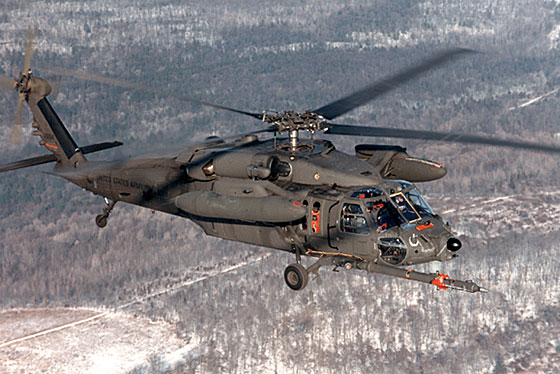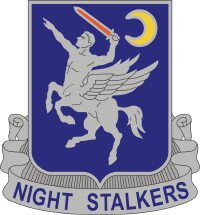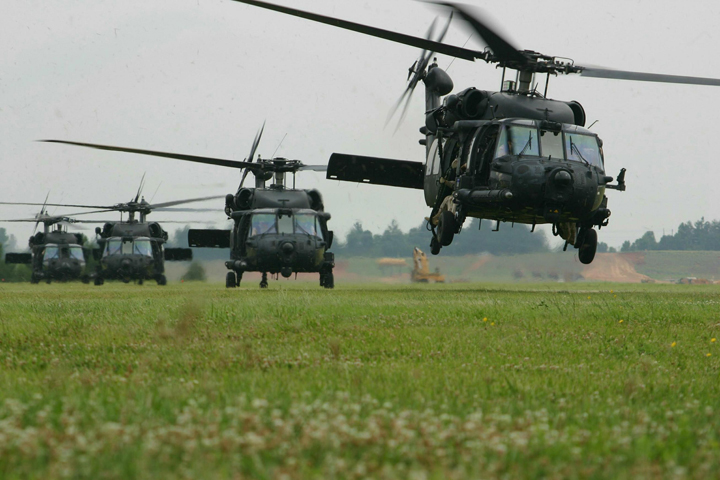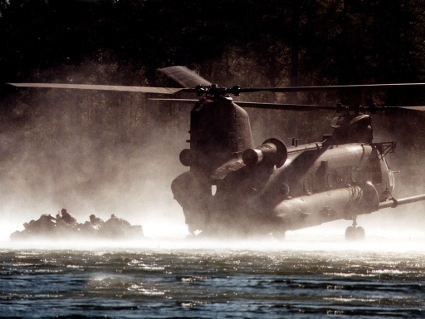Unit Profile
The 160th Special Operations Aviation Regiment (Airborne) or 160th SOAR (A) (Night Stalkers) , is a military unit specialized in providing aviation support to Army special operation forces. The unit was created in 1981 after the failure of Operation Eagle Claw, the hostage rescue action of the United States Special Forces in Iran.
The U.S. Army owes its modern night fighting aviation capabilities to the 160th SOAR (A) who pioneered night flight techniques and shared in the development of equipment. The 160th SOAR (A) has provided air support to most U.S. Army Rangers missions. Because of this, both units share most of their operations. The 160th SOAR (A) actively seeks and assigns the best-qualified aviators. Once assigned, incoming officers and enlisted soldiers go through special training programs in preparation for the unit's unique missions.
The regiment currently consists of three battalions, a headquarters company, the Special Operations Aviation Training Company, and two forward-deployed companies located in the U.S. Southern Command and U.S. Pacific Command areas of responsibility. The 1st and 2nd battalions are located at Fort Campbell, Kentucky (USA) while the 3rd Battalion is located at Hunter Army Airfield, Georgia Georgia.
Mission
- Provide aviation support to U.S. Special Operations Forces.
Raised and Disbanded
- raised: October 16th, 1981 Task Force 160;
- redesignated: 1986 , 160th Aviation Group (Airborne);
- redesignated: May 1990, 160th Special Operations Aviation Regiment (Airborne).
Units
- Headquarters;
- 1st Battalion;
- 2nd Battalion;
- 3rd Battalion;
- 4th Battalion;
- Training Company;
- Forward-deployed company located in the U.S. Pacific Command;
- Forward-deployed company located in the U.S. Southern Command.
Size
- ~1,800.
Headquarters
- Fort Campbell, Kentucky, United States.
History
Following the April 1980 failure of Operation EAGLE CLAW, the attempted U.S. hostage rescue in Iran, President Carter appointed Admiral James L. Holloway, III, the former Chief of Naval Operations, to head a commission to study the deficiencies revealed by the operation. Among the findings was the fact that the military lacked aircraft and crews who were trained and prepared to perform these types of missions. The services would later formally address the findings of the commission, but, in the short term, the focus was on recovering the hostages.
To accomplish this task, the Army turned to the 101st Aviation Group of the 101st Airborne Division (Air Assault) at Fort Campbell, Kentucky. The division possessed the greatest number and variety of helicopters of any unit within the Army, and thus showed the greatest potential for the rapid development of a rotary wing special operations capability.
The special project known as Honey Badger would centre around the 158th Aviation Battalion. Companies C and D of the battalion had acquired the Army’s new UH-60 assault helicopter and would serve as the primary assault force for the project. The UH-60A Blackhawk was an easily deployable and highly capable assault helicopter and with its great power was able to carry large payloads at high speeds. The 229th Attack Helicopter Battalion would initially provide pilots for the light assault helicopters. They would later man the light attack component as well. OH-6A scout helicopters (Little Birds) were chosen for the light assault role because of their small size and ease of transport. The Little Birds could carry only three soldiers and a single pilot, but they could land in the most restrictive locations. Personnel at Fort Rucker, Alabama developed armed Little Birds as a separate part of the project. Selected 229th personnel would team with the Fort Rucker element toward the end of the initial project as Company B, 229th Attack Helicopter Battalion became the Little Bird organization of the Task Force. Company A, 159th Assault Support Helicopter Battalion would provide the heavy lift element of the new organization. CH-47C Chinooks, although not as easily deployable as the other aircraft, were capable of moving large numbers of personnel and heavier payloads. The Chinooks would prove most effective in the project by establishing forward area refuel/rearm points (FARPs) for long-range operations. Together, these men and aircraft formed Task Force 158.
The project began as separate training deployments. The Blackhawks were moved to Norton Air Force Base (AFB) in San Bernardino, California, on Air Force C-5 transport aircraft, while the Chinooks self-deployed. At Norton AFB, the Blackhawk aircraft were modified to increase their range and improve long-range navigation capabilities. Meanwhile, the crews were given intensive training over the California desert. Few of the aviators were qualified to fly with night vision goggles (NVG), and no one was qualified for NVG flight in the UH-60. In fact, the aircraft instruments and lighting were not NVG compatible, and modifications had to be made before training could begin. Once the aviators completed a 10-hour NVG syllabus, they progressed to long-range navigation training. Training flights consisted of up to seven and one-half hours of night flying with AN/PVS-5 night vision goggles (NVG). Pilots who completed the designated route, known as “Black Route,” three times with the NVGs were considered qualified. The Chinooks stopped at Reese AFB in Lubbock, Texas, and Luke AFB in Phoenix, Arizona, for refuelling and crew rest, and then joined the Blackhawks at Norton AFB. Pilots selected for the Little Bird helicopters were sent to the Mississippi Army National Guard Aviation Support Facility at Gulfport, Mississippi, for two weeks of training on the OH-6A helicopters. Following aircraft qualification, the Little Bird aircraft and crews were loaded on Air Force C-141 aircraft and moved to Fort Huachuca, Arizona, for two weeks of mission training.
Armed OH-6 aircraft would join the training program later in the fall of 1980. Ultimately, aircrews would perform missions over routes as long as 1000 nautical miles. Little Birds would load on C-130 transports and move to appropriately located forward staging areas to train for their role in the mission.
All of the units continued extensive training throughout the summer and fall of 1980 in desert environmental skills and long-range, close-formation precision navigation with NVGs in preparation for the unspecified mission. Late in the fall, the aircrews were asked if they wished to volunteer to continue with the project. As expected, most volunteered to remain. At this time, the volunteers were given their first formal briefing on Operation Honey Badger, which was to be the air component of a second attempt to rescue the U.S. hostages from Iran.
On January 20th 1981, the hostages were released, and Operation Honey Badger was cancelled. The men of Task Force 158 expected to disband and return to their former units; however, Army leadership determined that the unit was needed to meet future contingencies. The new unit, soon to become the 160th Aviation Battalion, consisted of a Headquarters and Service Company (HSC), a Light Assault Company (MH-6s), and a Light Attack Company (AH-6s). With the addition of two Blackhawk companies and a company of Chinooks, Task Force 160 was formed. Sometime later, a maintenance company was developed from the maintenance platoon of HSC and added to the task force. The task force continued to train and develop specialized skills while operating from diverse locations on Fort Campbell to minimize the appearance of a non-standard unit. The 160th Aviation Battalion was formally activated at an open ceremony on the Fort Campbell Division Parade Field on 16 October 1981 immediately following the change of command ceremony for the 158th Aviation Battalion. LTC Jacob B. Couch, outgoing commander of the 158th, became the first commander of Task Force 160. A few months later, on April 1st 1982, the 160th Aviation Battalion was officially added to the Army’s rolls. The new battalion’s stated mission would be to provide additional flexibility to the commander of the 101st Airborne Division (Air Assault) while experimenting with new and improved air assault tactics, techniques and procedures. In reality, the Army’s special operations aviation unit had been quietly but openly activated.
Badge of Task Force 160
The 160th was first used in combat during Operation Urgent Fury. Since 1983, the unit has responded to numerous missions at the request of the National Command Authority. This includes Operation Mount Hope III in June of 1988. In Operation Prime Chance, the Night Stalkers successfully used night vision goggles and forward looking infrared devices for the first time in night combat.
The organisation continued to grow. In 1986 it became an airborne Unit, redesignated as the 160th Aviation Group (Airborne). It was officially activated as the 160th Special Operations Aviation Regiment (Airborne) in May of 1990. Responding to an increased demand for elite highly trained special operations aviation assets, the Regiment activated three battalions, a separate detachment, and incorporated one National Guard battalion.
Night Stalkers were called upon to spearhead Operation Just Cause in Panama, and they were also used in the First Gulf War in 1991. In October of 1993 in Somalia, Night Stalkers became involved in the incident called the Battle of Mogadishu, which later became the subject of the book and movie Black Hawk Down.
Operations
- Operation Urgent Fury - Grenada, 1983;
- Operation Prime Chance - Persian Gulf, 1987 – 1989;
- Operation Mount Hope III - Chad, 1988;
- Operation Just Cause - Panama, 1989;
- Operation Desert Shield - Iraq, 1990;
- Operation Desert Storm - Iraq, 1991;
- Operation Restore Hope - Somalia, 1993;
- Operation Gothic Serpent - the operation that led to the Battle of Mogadishu, 1993;
- Operation Enduring Freedom - Afghanistan, 2001 - present;
- Operation Iraqi Freedom - Iraq, 2003 - 2010;
- Operation New Dawn - Iraq, currently ongoing.
Equipment
The 160th SOAR fly MH-47G Chinooks, A/MH-6M Little Birds, MH-60K Black Hawks and MH-60L Black Hawks.
Training
Early training took its toll on the task force and threatened its future existence. From March to October 1983, four aircraft and sixteen personnel were lost. Because of these accidents, the Army convened a Blue Ribbon Panel at Fort Campbell, Kentucky in October of 1983. The panel recommended the creation of a dedicated training program, which quickly became known as Green Platoon. The program would later evolve into the dedicated Special Operations Aviation Training Company.
The Systems Integration and Management Office was also created in order to organise and manage the many aircraft programs that were required to support special missions. The training company centralized and standardised the fragmented training of the unit, and enabled the highly skilled volunteer pilots recruited by the unit to become properly qualified as special operations pilots. After four months of rigorous training supervised by an experienced special operations pilot, the pilots were certified as Basic Mission Qualified (BMQ) and could serve as co-pilots on missions. After 12 to 18 months of training and experience in an operational company, pilots were certified as Fully Mission Qualified (FMQ) and could serve as command pilots and planners on special operations missions. A further 36 to 48 months of sustained high performance qualified selected pilots to be designated as Flight Lead Qualified and plan and lead special operations aviation missions. Implementation of recommendations made by the Blue Ribbon Panel drastically reduced task force training accidents and prevented the dissolution of the unit.
Photos
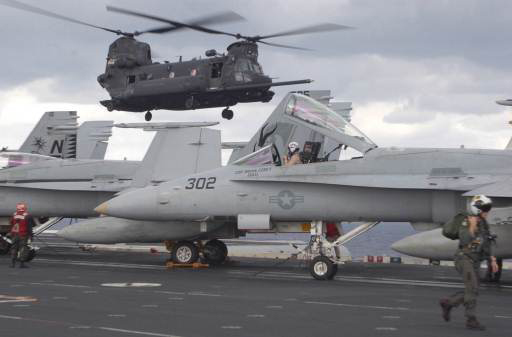
A U.S. Army MH-47 Chinook Special Operations helicopter deployed from Okinawa, Japan, approaches the flight deck of the aircraft carrier USS Kitty Hawk (CV 63). Army helicopters landed aboard Kitty Hawk as part of approach training and carrier qualifications exercise with the Navy. Pacific Ocean, Nov. 05, 2002.
[Photo: PH3 TODD FRANTOM / U.S. Navy.]
Video: 160th SOAR(A) "Night Stalkers" Recruitment Video
References
- 160th Special Operations Aviation Regiment (Airborne) “Night Stalkers" / Campbell.Army.mil
url<http://www.campbell.army.mil/units/160thSOAR/Pages/160thSOAR.aspx>

